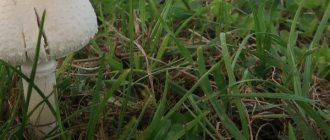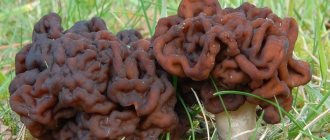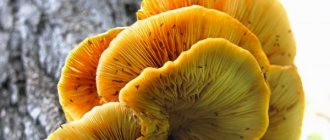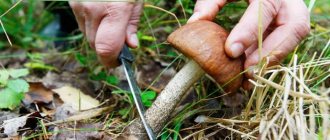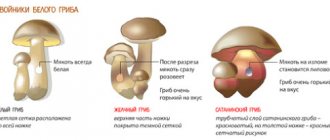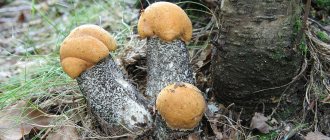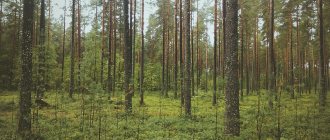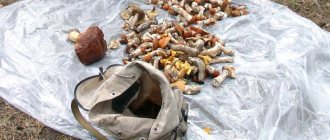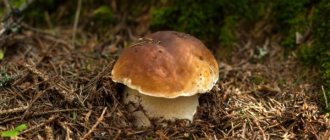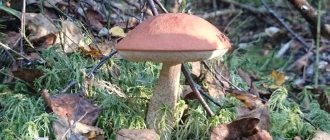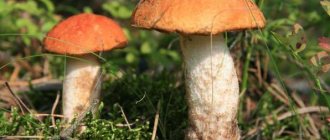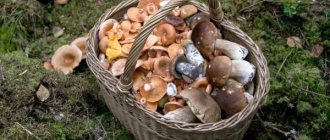In this article you will learn a lot of detailed information about boletus.
Boletus mushrooms are considered the most popular among fans of forest hunting in the fall. Mushrooms have impressive sizes, bright colors, caps that can be seen even in tall grass. But finding these mushrooms during leaf fall is sometimes quite difficult. Varieties of boletus mushrooms include a huge range of colors, however, as a rule, all mushrooms resemble the color of yellowed or reddened aspen leaves.
Boletus (also known as aspen or redhead) is one of the types of mushrooms that belong to the genus Leccinum. This species received its own name due to the fact that it grows mainly under aspen trees.
Why is it called boletus?
Most people will immediately guess where the “legs grow” from such a name.
Indeed, just like the boletus, the boletus is named because of its habit of growing under certain trees. However, it is not always possible to find this representative of the mushroom family under the aspen tree. The fact is that different types of boletus can be found in spruce, birch and coniferous-deciduous forests. Some believe that the name of the boletus is related to the color of its cap. It resembles the shade of aspen foliage in autumn. By the way, the popular names of the mushroom are precisely connected with this - red mushroom, red mushroom, red mushroom. And the people also nicknamed the boletus “Vanka-Vstanka”. He apparently received such an interesting name because of his tall stature and slender figure.
As already mentioned, it is almost impossible to distinguish types of boletus by taste. But it’s worth knowing them so that you have no doubt when collecting – take the mushroom you find, or leave it to be eaten by forest dwellers.
This mushroom is completely edible. In symbiosis, it is intertwined with the root system of aspen and other various trees: willow, birch, as well as oak, etc. It grows large - up to 15 or even 30 cm in diameter. The stem reaches 5 cm in thickness, and can even be as high as 15 cm. The color of the cap is usually red, bright red or brownish. The leg has scales of a grayish tint, which darken over time. The flesh of the red boletus darkens when cut. You can meet this representative in almost all parts of the country. It usually grows near young aspens and is often found along forest paths and ditches. You can start hunting for such a mushroom in June and continue until September.
Yellow-brown
This type of boletus is also called red-brown boletus or multi-skinned boletus. Its peculiarity is the creation of mycorrhiza with birch trees. You should look for such mushrooms in forests where there are most birch, aspen and spruce trees, sometimes growing in pine groves. They like to settle in forest belts and are most often found in areas with moderate climatic conditions.
The cap grows on average up to 15 cm, the leg - up to 22. The support is covered with scales, which change color from brown to black with age. The hat has a light orange tint, sandy, sometimes yellow and brown. The skin is dry on top and often hangs over the edges of the cap. The pulp is light, but when cut it begins to turn pink, and then turn blue, even acquiring a purple tint.
This variety is a real rarity. The mushroom is listed in the Red Book and is not easy to detect. It grows in coniferous forests, but if there are birch trees in them. If the weather is dry, it grows between aspen trees. Loves damp areas. The white cap turns gray with age, even acquiring a brown tint. It grows up to 25 cm. The dense flesh turns blue, and over time even turns black when cut. The cream leg grows tall, and the scales on it are also light.
Redhead or oak grass
Very similar to the common boletus, but likes to grow near oak trees. The cap grows up to 15 cm, the leg reaches the same height, and the thickness varies from 1.5 to 3 cm. The color of the cap is brown, but with a noticeable orange tint. The scales on the support are reddish-brown.
Paintedfoot
This specimen is not like its counterparts. His hat is pinkish and convex. The scales on the support are red. Above it is white-pink, and towards the bottom its color becomes yellow, ocher. This boletus loves coniferous and deciduous forests.
Redhead pine
Has a red-brown cap. Its surface is velvety and dry, and its diameter is about 15 cm. The height of the leg is 14 cm, the thickness is approximately 5 cm. It has small brown scales. The flesh turns blue at the break and becomes black over time. The favorite place of this species is damp forests with coniferous trees.
Blackscale
This boletus has a red-orange cap with a brick tint. The skin is dry and velvety at first, but becomes smooth over time. The cap reaches 12 cm, the height of the stem can be 18 cm. The scales on it are reddish. The pulp darkens when cut, first becomes purple and then grayish-black.
Redhead spruce
The color of his cap is bright chestnut. The skin hangs over the edges. The leg is cylindrical with light brown scales. It expands towards the base. The pulp becomes covered with dark spots after the cut. Such representatives of boletuses grow in oak forests, coniferous forests, and mixed groves.
Where to collect boletuses: video
Review of chemical products against greasy stains on kitchen furniture
The store offers a selection of universal cleaning products that are suitable for different types of stains and surfaces.
Saving time on choosing an option for home fat removal, you can buy a 5 in 1 or 7 in 1 product, but you will not get the desired effect. As practice shows, the more universal the chemistry, the worse the result.
Review of products of various consistencies:
- Liquids, foams. Convenient to apply to contaminated surfaces. The package includes a spray bottle for convenient use. You can clean soft carbon deposits and fresh grease stains.
- Cream, gel. They have a great effect and can be carefully dosed onto a dirty area of kitchen furniture. Read the packaging carefully; many products of this type contain abrasives that scratch surfaces.
- Powder. Ideal for hard surfaces with burnt, light greasy stains. Their shape allows you to scrape off dirt layer by layer.
According to acid composition there are:
- Alkalis. Suitable for cleaning metal. It is not advisable to use it often, they destroy the coating.
- Acids. The composition is strong or weak, concentrated or not. If the pH is 3-5 (low) it can be used on tiles, laminate, if the pH is 1-3 (high) it can be used against rust and plaque.
- Neutral. They are universal. You can wash grease in the kitchen, home furniture, and household appliances. Such means will not be able to remove plaque, rust, and fumes.
According to the composition of active components:
- Abrasives. A crumb that can remove any dirt from all surfaces. Disadvantage: it leaves scratches on furniture.
- Organic solvents. Moisturizes dry spots, penetrates fat molecules, facilitating easy removal.
- Acids. Remove rust, lime deposits, and scale. It is not advisable to use on gold-plated coatings.
- Oxidizing agents. Disinfect and oxidize organic dirt on furniture.
- Alkali. Effective in the fight against old stains. Do not wash aluminum cookware.
- Surfactant Dissolve fat. Hard means. They can only be used with gloves.
Chemicals quickly remove any stains, including soot and grease deposits on kitchen furniture.
How to remove grease from kitchen furniture:
- Amway has a powerful cleansing formula. The product dissolves fat from the inside. LOC detergent degreases surfaces. First, pour 375 ml of water, then add 125 ml of detergent. The composition is sprayed on the surface and wiped with a rag. Particularly stubborn dirt is removed with a 1:1 solution.
- Schumanite is suitable for all surfaces. When working with it, you need to wear a respirator and gloves. Schumanite is toxic and harmful to the body. How to wash off grease: apply spray to the surface, wait 5–10 minutes, remove with a damp cloth. Ventilate the room after treatment.
- Silit Beng Anti Grease Shine effectively removes oil stains and stubborn dirt. How to quickly wipe off greasy deposits from furniture in the kitchen: spray the composition on the cabinets, wait 5 minutes, rinse with water.
- Mr. Muscle will save plastic surfaces, glass and tiles from accumulated grease and soot. It is also used for a headset, but it is not as effective (you will have to use it several times). There are two types of sprayer: spray and foam, the first type is for horizontal surfaces, the second is for vertical surfaces. Spread the mixture over dirty surfaces and leave for 5 minutes. Then rinse off with warm water.
Professional chemistry is an indispensable tool
It is important to distinguish between products for metal, glass and tiles, furniture. How to wash off grease on a kitchen cabinet using traditional methods or household chemicals is up to the owner of the kitchen to decide.
The main thing is that after cleaning the room is cozy, clean and comfortable.
We invite you to familiarize yourself with Decoupage for beginners: step by step with photos, 7 master classes!
What types of boletus exist?
The most interesting boletuses:
- yellow-brown;
- pine;
- red;
- oak;
- colored-legged.
Red-brown (Leccinum versipelle; yellow-brown) boletus
Yellow-brown (red-brown) boletus
This common mushroom is edible when properly prepared. Typically harvested in Finland and surrounding regions. It is found under birch trees from July to November; after heat treatment it turns black. This is the earliest type of mushroom, harvested at the beginning of June.
The rough cap is broadly convex, bright red-brown or brick red, and grows up to 20 cm in diameter. The flesh of a ripe mushroom is white to pink in color and turns green when cut, especially on the stem. The spores are brown. The white, hard stem of the mushroom is long and straight, covered with small black scales.
Yellow-brown boletus is moderately toxic (causes nausea and vomiting) if not properly cooked: frying or boiling for 15–20 minutes is necessary. As mentioned, the mushroom turns black when heated.
Pine boletus (foxy bolete)
Pine boletus
These mushrooms are rarely found by less experienced mushroom pickers. Experienced mushroom hunters find them by their characteristic features and do not confuse them with other types of mushrooms.
The cap at the top is brick or chestnut with a shade of red, up to 10 cm in diameter. The gills and pores are whitish, becoming gray after damage. The leg is covered with white scales and is up to 4 cm in diameter. When exposed it turns dark red or brown.
The pulp is white. On the cap, when pressed, the damaged area slowly turns red, at the base it acquires a greenish tint, and at the center of the stem it becomes wine-red.
Pine boletus cap
Pine boletus is found under pine trees in coniferous and mixed forests. This boletus does not grow under aspen trees. The mycelium is more prolific in the presence of areas covered with moss.
Pine boletus is harvested from July to the end of October. The end of September, the beginning of October is the most productive time.
There are no dangerous, false, poisonous pine boletuses. People fry and boil these mushrooms, and pickle young boletuses.
Red boletus (Leccinum aurantiacum)
Red boletus
They are found in the forests of Europe, North America and Asia and have a large body, characteristic of boletuses.
The cap is orange-red, up to 20 cm in diameter. The flesh is white, burgundy in places of damage, then grayish, purple-black. The lower part of the cap has small whitish pores that turn bluish-brown when cut. The leg is whitish, 10-18 cm high, 2-3 cm thick, and when exposed, acquires a bluish tint. The short, hard projections on the stalk turn brown or black with age.
Leccinum aurantiacum fruits in summer and autumn in forests in Europe and North America. The relationship between the fungus and the host tree is mycorrhizal. Traditionally, the mushroom is associated with poplars, but these boletuses are also found among oaks and other deciduous trees, including beech, birch, chestnut, and willow.
This mushroom is prepared like other edible boletuses. The flesh of red boletus darkens when cooked. Like most other Boletaceae species, overripe mushrooms are loved by insects and lay larvae in them. If you do not prepare it in accordance with the technology, after eating red boletus you may experience vomiting and digestive problems.
Oak boletus (Leccinum quercinum)
This mushroom bears fruit near oak trees from June to early October in small families.
Young specimens have a characteristic brick-red or brown cap, 5-15 cm in diameter, “stretched” over a stalk, in the shape of a ball. With age, the cap of Leccinum quercinum takes on the appearance of a pillow and becomes flattened with aging. Avoid old mushrooms with flat caps. A person does not digest the protein that is formed in the body of overripe oak boletuses.
The surface of the cap is rough in humid conditions and cracks on hot days. The white-gray fruit body is dense; when broken, dark gray spots appear. Soon the damaged area becomes blue-purple, and eventually blue-black.
Fluffy brown scales cover the surface of the leg. Its shape is solid. The leg grows up to 15 cm, diameter up to 5 cm, grows deep into the ground, thickens at the bottom.
Gyroporus chestnut
Another representative of the Gyroporus family. Belongs to the department Basidiomycetes, forged Agaricomycetes. Genus: Gyroporus.
hat
The cap of this mushroom has a characteristic rusty tint with brown spots. Less often it is red-brown. Even rarer is the chestnut shade. The younger the mushroom, the lighter its cap, but with age it becomes darker. The diameter of the mushroom reaches 11 cm. The surface of this mushroom, if you run your hand over it, is quite velvety. Also a little fluffy. Less often it is bare and without a single lint. If the sun's rays hit the mushroom cap directly, it begins to crack. If you look under the cap, the tubes inside are first white, then acquire a yellow tint. As for older age, the cap becomes less elastic and drier.
Pulp
Special attention is paid to the pulp. It is quite white, and at the same time it tries not to change its color when cut.
At first it is quite hard, but meaty. However, with age it becomes more fragile. At the same time, its smell and taste are quite unpleasant, so many people prefer to avoid chestnut gyroporus.
Leg
The leg is quite stable. It is unevenly cylindrical, but at the same time it can bend at any angle. Club-shaped and rather flattened. Dry, reaches a height of up to 30 mm. Same thickness. The inside of the leg is quite elastic, but with age this elasticity is proportionately lost. Often the cap outweighs the stem and breaks off.
Where to grow and when to go
If you're looking to find the Chestnut Gyroporus, you're in luck. This mushroom is especially widespread in the central territory of Russia. It grows in a large brood at once, so if you spot it in a clearing, know that there are probably many of its brothers around.
This mushroom grows from July until November, provided that the autumn is warm. If it is cold, then you need to go for mushrooms in late September early October.
For growth it prefers coniferous and at the same time deciduous forests. Also, it mainly prefers sandy soils, preferably moist soils. Loves dry soils, settles away from swamps.
The fruiting bodies are somewhat spread out from each other, however, they are still grouped well. In one clearing you can find up to thirty mushrooms at the same time.
Edibility Gyroporus chestnut
Many people say that chestnut gyroporus is much worse in taste, in contrast to blue gyroporus. This is true. Despite the fact that this mushroom is edible, it still has a very specific taste.
First, you feel the aroma of champignons, and then it acquires a bitterish tint. Even after heat treatment, this mushroom cannot be eaten. At some point it becomes so bitter that there is nothing left to do but throw it away. Also, it can permeate absolutely all the ingredients that were prepared with it with bitterness. For example, if gyroporus is mistakenly baked with potatoes, the potatoes also become very bitter.
Therefore, this mushroom is best used as a seasoning. Indeed, a slight bitterness will not be a problem for some people, and in general, this mushroom perfectly replaces pepper and becomes more aromatic.
To prepare the seasoning, you need to perform the following steps.
To begin with, the mushroom is washed well under running water.
Remove all trash. The mushroom is well dried and cut into several parts. Then boil for about 10 minutes in boiling water. The mushroom is salted again, and then it is carefully placed on baking paper on a baking sheet. The oven temperature is set to 60-70 degrees. The mushrooms are sent there for one and a half to two hours.
However, check the readiness periodically. To do this, you need to take a piece of mushroom in your hands and try to break it. As soon as this happens with a crunch, it means the drying mode is over. Now you need to let the mushrooms cool at room temperature. However, try not to make it humid. Once the mushroom has cooled, we suggest grinding it in a coffee grinder. Ready, tasty and bitter seasoning will decorate any of your dishes.
What does a boletus look like?
Despite the diversity of species, boletuses (or red mushrooms, red mushrooms, etc.) are distinguished by their massiveness, elastic stem, bright cap and dense consistency of the fruiting body. The diameter of the cap varies between 5-20 cm. Sometimes you come across real giants - about 30 cm.
Young boletuses
If the mushroom is young, then its cap has a hemispherical shape. It wraps the leg tightly. With age, it becomes convex, pillow-shaped, and then completely straightens.
The skin is usually impossible to remove. It is dry to the touch, sometimes velvety. The leg is club-shaped (thick at the bottom, thin at the top). It grows up to 22 cm. The leg itself is light, but covered with numerous dark scales.
Tubular layer of boletus
The spore-bearing layer of boletus is tubular. Its thickness is about 1-3 cm. The color is usually white, yellow, gray or brownish. The spore powder is brown or olive-brown in color.
The cap flesh is dense, elastic and fleshy. The stalk is characterized by a longitudinal arrangement of fibers. The pulp is white, but if damaged it quickly turns blue, and, after some time, turns black.
conclusions
So what can be advised to novice mushroom pickers who go into the forest to look for boletus mushrooms? First of all, you need to remember the universal rule: if you are not sure of the type of mushroom you find, then it’s better not to take it! Look carefully at its leg and its cut: it should alert you.
The first forest beauties in bright hats under an aspen leaf can be seen by mid-June. Not a single mushroom picker can pass by such a “trophy”, even those who come to “quiet hunting” for the first time in their life. The boletus mushroom looks so bright and “juicy” - slender, bright and noticeable from afar. This “worthy” appearance is truly matched by the best mushroom qualities.
Boletus is a general name for a number of mushrooms of the genus Leccinum. Class Agaricomycetes, family Boletaceae. Other names: aspen mushroom, chelish, redhead, obabok, red mushroom.
Main types: red, yellow-brown and white. There are also oak, pine, black-scaled and painted-legged. Although the genus of the latter is controversial. Most of them can be immediately distinguished by their characteristic appearance - a “headdress” of orange-red tones (very rarely white), a stocky, fairly high leg with dark scales.
A special feature of any boletus is the flesh that turns blue when cut, not only the stems, but also the caps. The blue color occurs due to the interaction of the chemical compounds quinometides from the mushroom juice with oxygen. When broken, the chemicals quinones are formed, which successively color the boletus cut and the entire flesh slightly pink, and then bright blue and black. Such changes do not pose a health hazard.
White
White boletus (Leccinum percandidum) or White aspen. The representative from the Red Book is considered a rare species.
- The size of the cap is 4-12 cm in diameter, can “reach” up to 25, fleshy. Ivory in color, cream or light brown, becoming yellowish with age. Dry to the touch, felt-like or bare. Sticky in wet weather. In young fruiting bodies, they are hemispherical in shape and gradually become cushion-shaped.
- The pulp is white, compacted, yellowish or greenish closer to the base of the stem. At the site of the break it quickly turns blue, reaching a purple tint in the stem. Then it turns black.
- The leg is up to 15 cm long, 1-2.5 cm in girth. Club-shaped, thickened downward. White, with oblong scales of the same color, which later acquire a dark, almost black color.
- The tubular layer is at first light milky, then acquires a shade of gray with orchid.
Yellow-brown
Yellow-brown boletus (Leccinum versipelle), otherwise red-brown, variegated boletus.
- The color of the cap ranges from yellow-brown to bright orange. The diameter of the surface can grow up to 25 and even 30 cm. The shape is hemispherical, gradually expanding into a pillow-like shape. The skin is slightly fluffy, dry, and with increasing humidity it becomes slightly sticky and may hang slightly over the edge of the cap.
- The pulp is light milky, strong, when cut it turns slightly pink, successively turns gray, then becomes pink-lilac, blue and violet-black.
- The length of the leg can reach 22 cm, thickness up to 5 cm in diameter. The shape resembles a mace, placed on the ground with the wide part. Covered with frequent longitudinal scales, gray-black along the entire length.
- The tubular layer is pale gray to orchid gray.
In the northern territories, such aspen trees grow up to 2 kg, and are rarely affected by worms.
Red
Red boletus (Leccinum aurantiacum) or Redhead. Other names: krasyuk, krasik, krasnik.
- Hat. Standard shape for boletuses. In span it grows from 4 to 20-25 cm. In small mushrooms it is practically “put on” the stem and gradually straightens. The surface is smooth or slightly velvety. The color depends on the place of collection. Mixed forests “color” the cap in orange or red-yellow, in aspen forests the mushroom “dresses” in dark red, and near poplars in different variations of whitish-gray shades.
- The pulp is no different from the yellow-brown boletus.
- Leg dimensions: height from 5 to 15 and maximum 28 cm, girth 1.5-5 cm. Cylindrical with thickening at the base. With longitudinal fibers of whitish brownish scales that darken to almost black color as they mature.
- The tubular layer is whitish with a gray coating, becoming yellowish or olive with age.
The red boletus differs from the yellow-brown one in its “solidity” and lighter scales along the leg.
Description of false
Not all lovers of “quiet hunting” know that there is a double of the boletus, considering this species to be quite unique. But in nature there is still a mushroom very similar to it.
hat
His hat is of medium size, it is round-convex and fleshy. It comes in different colors: red-brown, yellow-red, red-orange. In young mushrooms, the inside of the cap is white, but with age it becomes grayish.
Leg
It is slightly swollen, irregularly shaped, thickened at the base. This part has a pink or yellow mesh. The surface is covered with small dark brown scales, and the inner layer has a tubular structure; when cut, the white color changes to pink.
The white mushroom turned blue. White mushroom turns blue when cut
Experienced mushroom pickers are able to distinguish edible specimens from poisonous counterparts by several external signs. Beginners who are just starting to learn “silent hunting” should be more careful so as not to accidentally put a poisonous mushroom in their basket, which can cause severe poisoning.
One of the signs that a specimen is poisonous is a change in the color of the flesh. As a rule, it begins to turn blue when cut. However, this process does not always indicate that it is poisonous. Today we will look at the main nuances in which the porcini mushroom turns blue when cut and will provide information about edible and poisonous species, the flesh of which can darken when broken or mechanically damaged.
White mushroom turns blue when cut
There are quite a few subspecies of porcini mushroom, the flesh of which can turn blue when cut. As a rule, this process indicates that you have found Polish, or chestnut, which can really change the color of the flesh greatly when broken and raise doubts about edibility among novice mushroom pickers (Figure 1).
Note: Externally, Polish is very similar to ordinary white, but upon careful examination, certain differences are still present in these species.
In fact, it is considered quite valuable, despite the fact that in terms of external characteristics it is slightly inferior to white. It is typically found in coniferous forests where there are many mature pine trees, but it can sometimes be found in deciduous forests.
Figure 1. Blue flesh of the Polish mushroom
Fruiting begins in August and continues until September. It tastes like white and is great for eating fried, boiled, dried and pickled. The outer part of the cap is brown or chestnut brown. On the inside there are yellow-green tubes that turn blue when pressed. At the same time, the pulp has a pleasant mushroom smell. It is noteworthy that the Polish mushroom is not capable of accumulating carcinogens, radionuclides and heavy metals, so even adult specimens can be safely collected.
Poisonous doubles of porcini mushroom
Despite the fact that the white mushroom is considered quite common, and it is difficult to confuse it with a toadstool, it has several inedible counterparts. They are extremely rarely fatal, but can still cause symptoms of severe food poisoning.
The danger of false whites is that they grow in the same area as edible specimens, and sometimes in close proximity to them. In order not to accidentally put such a specimen in the basket, you should know the distinctive external signs of poisonous counterparts.
- Gall mushroom (gorchak)
Outwardly it is very similar to white, but prefers to grow on well-heated clay and sandy soils. Most often it can be found on the edges and clearings of coniferous forests. Based on the place of growth, it should look like white pine, although in fact, in terms of external characteristics, it is more reminiscent of oak (Figure 2).
Among the external characteristics of bittergrass, the following should be highlighted:
- The cap is convex, brown or brown in color.
- The leg is thick, cylindrical, covered with a characteristic mesh pattern, which is absent in true whites.
- The flesh is not a pleasant cream or white hue, but slightly pinkish or off-white. The gall pulp also acquires a pink color when cut or broken.
But the main characteristic feature of this poisonous twin is that it has a pronounced bitter taste, which is why the mushroom got its name. This taste not only does not disappear, but also intensifies during heat treatment, so you won’t be able to eat it by accident. It is the bitterness that is the reason why forest animals and insects do not eat it.
How to cook
The colored boletus, according to most printed sources, has a bland taste and an insufficiently bright mushroom aroma. But there is also an opinion that this is a very tasty mushroom. Therefore, all that remains is to try the dishes with this mushroom yourself to form your own opinion.
A useful property of the colored boletus is the presence of fleshy, dense and elastic pulp, which does not become soft during cooking, therefore the use of the mushroom in cooking is very wide: it is boiled, stewed, fried. There are many recipes for colored boletus for preparing first and second courses. The mushroom is used to prepare soups, sauces and even dumplings and cutlets.
Preparation and culinary processing
In terms of taste, absolutely all boletuses belong to the second category of nutritional value. They have dense, elastic flesh with a slightly sour taste. These mushrooms are mainly consumed pickled, salted, dried and fried. But, as a rule, young specimens are selected for conservation. The coarsened flesh of adults in the marinade remains as hard as raw potatoes. When harvesting or cooking boletuses, it is very important to take into account that their slightly crushed and darkened flesh very quickly begins to deteriorate and accumulate harmful toxins, often on the way home.
Therefore, it is recommended to process such mushrooms as soon as possible. It is necessary to cut off the darkened areas, and under no circumstances store them raw for a long time. Of course, old and very wormy specimens are also subject to rejection. Please note: boletuses selected for drying cannot be washed. You can only clean dirt and leaves with a soft brush. And already washed ones must be immediately subjected to heat treatment.
Useful tips
By following useful culinary tips and recommendations, you can easily prepare a mushroom treat for lunch or dinner:
- jars of mushrooms should be stored in a cool and dark room with an air temperature no higher than +8 ℃, where they will be ready in 1 month;
- to obtain a clear marinade, add a pinch of citric acid to the jar of mushrooms;
- It is recommended to fry mushrooms in an old thick-walled cast-iron frying pan;
- It is not recommended to take mushrooms older than middle age, since they are not as tasty as young specimens;
- young specimens should have a smooth, durable and evenly colored surface, which should be free of black spots and dark spots;
- Frozen boletuses can be stored for no more than 6 months;
- since mushrooms immediately begin to oxidize and darken upon contact with air, it is recommended to heat them immediately after cleaning and slicing;
- It is recommended to pour hot vegetable oil on top of the jar, which will have a positive effect on the softness and fat content of the marinade, preserving the mushrooms from spoilage;
- To prevent the mushrooms from darkening during cooking, it is recommended to add a little vinegar to the liquid;
- if the whole onion head does not turn red or blue during cooking with mushrooms, then the mushrooms are safe to eat;
- to dry or freeze boletus mushrooms, the surface of the mushroom cap must be wiped exclusively with a dry, clean cloth or toothbrush;
- so that the mushrooms can be fried in a frying pan, it is recommended that after washing and slicing the product, place it in a dry saucepan to evaporate all the liquid.
According to the recipe, which provides a photo and description of the marinating process, to give boletus mushrooms an original flavor, it is recommended to place up to 8 pieces in the marinade. juniper berries.
Where do white aspens grow?
White boletuses are found in the temperate climate zone. They are collected in coniferous, deciduous and mixed forests. Fruiting bodies form mycosis with birch, aspen, spruce, and fir trees. They occur in areas with high humidity. This includes places near ponds and streams, ravines, and lowlands. The white variety grows in the soil, on stumps, and in dead wood.
Attention! In many regions, white aspen is included in the Red Book. The variety is considered rare and is in danger of extinction in the Tula region and Krasnodar region.
The rarity of white boletus is associated with anthropogenic factors. As a result of human activity, the habitat of fungi is changing. First of all, the disappearance of boletuses is due to deforestation.
White boletus grows in the North-Western region, the Moscow region, the Republic of Chuvashia, Mari El, Komi. In Siberia, it is collected near Lake Baikal and in more northern regions. In Europe it is found in Belarus, Latvia, and Estonia. It is also found in the forests of North America.
The white variety grows solitarily, sometimes forming small groups. In dry summers, fruiting bodies appear in damp places where moisture constantly accumulates. When picking mushrooms, check clearings and areas near forest roads and trails.
Fruiting lasts from June to mid-autumn. Usually there are 3 waves of growth. The first fruiting bodies appear at the end of June. During this period, single specimens appear. The second wave is more abundant, its peak occurs in mid-summer. Individual mushrooms can be collected in September and October, when the third layer passes.
Description of false
Not all lovers of “quiet hunting” know that there is a double of the boletus, considering this species to be quite unique. But in nature there is still a mushroom very similar to it.
hat
His hat is of medium size, it is round-convex and fleshy. It comes in different colors: red-brown, yellow-red, red-orange. In young mushrooms, the inside of the cap is white, but with age it becomes grayish.
Leg
It is slightly swollen, irregularly shaped, thickened at the base. This part has a pink or yellow mesh. The surface is covered with small dark brown scales, and the inner layer has a tubular structure; when cut, the white color changes to pink.
Description of the Hungarian varietal group
It is believed that the Hungarian plum appeared through cross-pollination of cherry plum and sloe in the Caucasus; according to other sources, Asia is considered the cradle of this variety. In 1900, the Hungarian was brought to Russia from Hungary, which is how this species got its name. The varieties of the group have their own unique qualities, but there is also something that unites them.
Hungarian fruits are dense, with elastic pulp
- The trees are mostly medium in height with red-brown shoots.
- The trees are self-fertile or partially self-fertile.
- Hungarian of any variety has high yield.
- They are drought resistant.
- The period of full fruiting is 25-30 years.
- Hungarian plums are egg-shaped, lilac, violet or dark blue.
- There is a pronounced waxy coating.
- The fruits are dense, with elastic pulp.
In terms of care, this plum requires standard procedures: watering, weeding, fertilizing, pruning
In trees that are prone to abundant fruiting, it is important to install supports during fruit setting so that the branches do not break, especially if they grow at an acute angle
It is important to remember that Hungarian of any variety does not tolerate pruning of old branches very well. The cut areas on these trees take a very long time to heal, and a hollow can form in their place, so during pruning, garden pitch is used; all procedures are carried out with very sharp instruments treated in a solution of manganese or other disinfecting liquid
Similarity of common boletus with other mushrooms
The common boletus belongs to the genus of boletus, bears fruit on sandy and clayey soils in deciduous and mixed forests, preferring the neighborhood with birch trees. This is not a meadow mushroom, but can be found on lawns near the forest near birch trees.
External features:
- The cap is hemispherical or cushion-shaped. It can grow up to 15 cm in diameter. The surface is smooth; in damp weather, mucus forms on it. The skin color can vary from light gray to dark brown. The color depends on the type of neighboring trees and growing conditions.
- The pulp is white and emits a pleasant aroma. The shade does not change on the cut. At the break, another variety turns pink - pink boletus.
- The leg has a cylindrical shape, a grayish-white surface with longitudinal dark or light scales. It becomes tougher with age.
- Birch grass is not a lamellar, but a spongy species (the tubular layer is similar to a sponge). In young mushrooms, the bottom of the cap is white, in old ones it is a dirty gray shade and becomes fibrous.
Mushrooms similar to boletus mushrooms are boletus mushrooms. The difference between the latter is the following: if you cut the mushroom, the flesh will turn blue.
Other features of boletuses include a leg of uniform thickness along the entire length and a cap of orange or red shades. Mushrooms are edible; misidentification will not cause negative health consequences.
Externally, other varieties of boletus are similar, they can be eaten, they all have good taste characteristics. Bitterweed, similar to normal boletus and boletus, deserves special attention
It is important to know how to distinguish a regular mushroom from a double so as not to spoil the dish and avoid poisoning
Is it possible to save a wormy mushroom?
What to do if the mushroom is wormy, but it’s a pity to throw it away? Especially when he looks so strong and young. How joyful it is to meet a boletus, saffron milk cap, and boletus in a clearing! But often joy gives way to disappointment. It is very disappointing to see holes in the cut, indicating the presence of unpleasant guests. Of course, you don’t want to see worms in mushrooms. Is it possible to save your loot? Should you put your find in a basket and bring it home? Or is it better to throw it away immediately? It often happens that there are a lot of slightly damaged finds. Is it possible to eat them?
In general, you can eat them; the presence of worms in mushrooms does not make them poisonous. This has been tested over many years of experiments and confirmed by scientific research. You cannot get poisoned by wormy mushrooms; they are quite edible, but not everyone will like it if a worm gets into their plate. This creates a difficult situation - it’s a pity to throw it away, and it’s impossible to offer it to guests. Over the course of several decades, especially compassionate lovers of forest gifts have experimentally discovered how to get rid of the presence of someone in the mushroom pulp without much effort. And after appropriate processing, they ate them with gusto. So, if the mushroom is not rotten, it makes sense to fight for it.
Processing mushrooms in this case involves the following steps. You need to cut them into large pieces, then soak them in cold, highly salted water and leave for 3-4 hours. It is assumed that the worms will begin to flee, the cause of which is the salt. This is, of course, an unpleasant sight, but the desired result will be achieved. In this way you can easily clean the mushroom from unpleasant creatures. All that remains is to rinse everything thoroughly after the time has elapsed. When the worms from the mushrooms are removed, the forest beauties are saved, you can send them to the kitchen and start preparing your favorite dishes that will decorate your table.
Another popular method is drying mushrooms. It is also very easy to clean them of worms this way. The sun will help you cope with them. They will leave their habitat on their own in a hurry during the drying process. Processing mushrooms from unpleasant creatures in this way is not difficult.
Application
Processing boletus begins with thorough washing under running water. It is under running water, because The tubular (spongy) hymenophore is capable of holding a large amount of water due to its structure. The boletus quickly turns blue when cut - this area is not suitable for eating, it is cut off. Mushrooms can be boiled, pickled, stewed, dried, and can also be frozen.
Boletuses are edible mushrooms. They do not lose taste when processed. The fungal body is 90% water, so after processing it will significantly decrease in size.
The beneficial properties of boletus are used in medicine. With its help, they treat atherosclerosis, dysbiosis, gastrointestinal diseases and strengthen the immune system. The calorie content of ordinary boletus is 22 kcal per 100 g. The nutritional value of boletus (per 100 g) is:
- proteins - 22, 31;
- fats - 0.57;
- carbohydrates - 1.23;
- dietary fiber - 6.31;
- water - 88.24.
In cooking
The pine boletus is especially prized. Soups are often prepared with it. Recipe description:
- fresh boletus – 450 g;
- potatoes – 400 g;
- carrots – 150 g;
- onion – 1 pc.;
- vegetable oil – 1 tbsp. l.;
- salt, black pepper, herbs - to taste.
You can prepare many dishes from mushrooms
The mushrooms are thoroughly washed under running water and dried. Then cut into small pieces and throw into boiling water. Boil for 15 minutes, skimming off the foam. Dried redheads are boiled for 30 minutes. Peel and chop the carrots and onions and fry until golden brown. Next, add the diced potatoes to the pan. After boiling, remove the foam and add the fried onions and carrots. After 25 minutes, add salt and spices and turn off. It is advisable to let the dish sit for 15-20 minutes before serving.
Fried boletus also turns out delicious.
Description of preparation:
- mushrooms – 500 g;
- vegetable oil – 2 tbsp. l.;
- onions – 2 pcs.;
- sour cream – 300 ml;
- salt, pepper - to taste.
First, fry the onion in vegetable oil until golden brown, then add peeled and washed mushrooms to it. The ingredients are simmered until the liquid has evaporated, and then fried until golden brown for about 12 minutes. Then add sour cream, salt and spices, mix everything well. Simmer the mixture over low heat for another 5 minutes. The dish goes with any side dish. It will be especially tasty if you use spruce boletus.
Pickled boletuses are especially tasty. For 1 liter of water take:
- mushrooms – 1 kg;
- salt – 85 g;
- vinegar 9% – 1 tbsp. l.;
- bay leaf – 4-5 pcs.;
- black pepper, cinnamon, garlic;
The mushrooms are washed, peeled, cut, filled with water and boiled for 10 minutes, then the water is drained. Next, prepare the marinade. All ingredients except vinegar are added to the water. Add mushrooms to the boiling liquid and cook for another 30 minutes. Later add vinegar and garlic and after another 15 minutes remove from heat. The mushrooms are placed in pre-sterilized jars, filled with marinade and rolled up. The number of kilograms of mushrooms depends on the volume of water.
Pine boletus is suitable for drying. Only fresh and worm-free mushrooms are used. They are washed, peeled and cut into small pieces. Then place it on a napkin or towel and leave to dry.
Boletuses are dried in the oven at 50°C, the door is left slightly open. The mushrooms darken a little after processing. They are stored in a tightly closed glass jar or cloth bag soaked in salt. Dried boletuses are suitable for consumption throughout the year; they are used in dietary food.
In medicine
The medicinal properties of boletus have been known for a long time. They treat herpes on the lips, frostbite and other skin diseases. The product heals wounds well.
It is also used for the following diseases:
- dysbacteriosis;
- depression;
- nervous breakdown;
- weak immunity;
- atherosclerosis;
- benign and malignant formations;
- gastrointestinal diseases.
These mushrooms are often used in powder or tincture form. Red boletus is often used for medicinal purposes. An alcoholic mushroom tincture is prepared according to the following recipe:
- Hats are cut off. They do not need to be cleaned, just rinsed and dried. Then put it in a container and fill it with vodka or alcohol.
- Leave the mushrooms to infuse for a while in a warm but protected from the sun place. Before use, filter the medicine.
Take 3 tbsp. l. per glass of water. The treatment period lasts a month. The product is also effective as a preventive measure. Its regular use helps improve the functioning of the intestines and stomach.
It is also possible to dry the boletus and grind it into powder. This remedy is taken 3 times a day before meals, 1 tsp.
Useful properties, vitamins, minerals
Now we need to disassemble the boletus according to its composition:
- vitamin PP;
- vitamin E;
- vitamin C;
- vitamin B2;
- vitamin B1;
- magnesium;
- sodium;
- phosphorus;
- iron;
- calcium.
The blue mushroom is oxidized by oxygen
The blue mushroom is oxidized by oxygen from the environment due to the pigment variegated acid. And when the mushroom turns blue, it contains a large amount of quinomethide anion, which is absolutely harmless to the human body. But it's not useful either.
Boletus, the beneficial properties of which are discussed in the following list, is one of the richest mushrooms in substances necessary for the human body:
- increases immunity;
- removes toxins from the body;
- low calorie content – 22 kcal per 100 grams;
- reduces cholesterol levels;
- improves the quality of vision;
- increases the amount of hemoglobin;
- help solve problems with flatulence.
Of course, the benefits of these mushrooms are much greater. Only the main medicinal properties are given here. Do not forget that the blackening mushroom is poisonous and has no beneficial properties, so it is better to dispose of it immediately.
How to distinguish boletus from false mushrooms
If you carefully study the characteristics of the boletus and photographs of its doubles, then you can deduce several basic characteristics of false boletuses.
The true redhead has a tall, dense and light-colored leg, covered with recognizable gray scales. A real aspen tree should not have a yellowish or reddish network or “vessels”; these are signs of false doubles.
If you break the redhead in half, its flesh will remain white or slowly turn blue or black. If the mushroom looks like a boletus and turns pink or red when cut, then it is a double.
The raw pulp of true aspen has a neutral taste and does not bring any unpleasant sensations. Inedible doubles taste bitter or hot, and there is no desire to eat them.
In size, a real boletus is quite large - about 15 cm in height and the same in diameter of the cap. Some of the look-alikes, such as the pepper mushroom, are much smaller.
How long does the boletus grow, when to collect
What time is most favorable for collecting boletus? It is advisable to go on the 2nd day after heavy, long-lasting rain. Because it is thanks to the abundant moisture that the mushroom can grow to large sizes in the shortest possible time. If the weather is too hot or cold, the mushroom will grow to its optimal size in about one week. When collecting, do not forget that the boletus must be cut, and not pulled out or twisted. Otherwise, you may damage the mycelium, which means there will be fewer mushrooms next year.
Varieties and their features
- Red aspen (Leccinum aurantiacum) is noticeable from afar: it has a stocky body, a scarlet cap and a powerful white leg. If the mushroom is damaged, it may take on a slight blue tint, which looks somewhat scary;
- Yellow-brown (Leccinum versipelle) is the largest of all boletuses; the cap has been recorded to reach 30 cm in diameter. Some people are afraid to collect it, but the mushroom is completely harmless;
- White (Leccinum percandidum) becomes grayish as it grows. It has a strange and scary appearance, but is legal to eat. When broken it also turns blue or black;
- Oak (Leccinum quercinum) is a powerful mushroom with a spherical shape. Its cap gradually grows to 30 cm, and the height of the fruiting body reaches 22 cm. Unfortunately, its lifespan does not exceed 11 days, so it is difficult to find;
- Pine (Leccinum vulpinum) has a miniature round cap with a brown-red skin. Over time it acquires a pleasant raspberry hue. The flesh also becomes a little darker, but this is absolutely normal;
- Painted-footed aspen (Leccinum chromapes) differs from other aspens. It has a soft pink cap and a yellow base. This variety is rarely used by humans, because most often it is affected by pests.
Types of mushrooms of the Boletaceae family
Where does such external diversity of boletus come from? There are several varieties of this mushroom:
The cap of the common boletus has a semi-convex shape. The leg is whitish, cylindrical, with pronounced scales, 4 cm in diameter and 17 cm in length, at the point of cut it begins to turn pink.
The gray boletus has an alternative name: hornbeam. Its cap is brown in color, and the yellowish flesh, when broken, begins to turn blue (to a violet hue) and then turn black. Longitudinal fibers are clearly visible on the stalk.
The marsh boletus, which loves damp places, is distinguished by a brown cap and a light-colored leg. To test the mushroom for edibility, break the stem: it should not turn blue.
Despite their bright color (from pink to bright orange and brown), multi-colored boletus mushrooms are not very popular among mushroom pickers. The reasons for this are the not very pleasant taste and difficulties in preparation.
The black boletus stands out among its relatives due to its corresponding color. Large tubes in the porous layer and black scales on the legs are its distinctive features.
Pink boletus is found in North America and Europe. So named for the peculiarity of the pulp, which begins to turn pink in fracture zones.
The white boletus is distinguished by the corresponding cap color and creamy flesh. This species is so unpretentious that it can be grown in the garden.
Stiff boletus grows in mixed forests. It is distinguished by a cap in a palette from gray to pale purple on a high stem. This species is loved by mushroom pickers, since the tough flesh is not very attractive to worms. And the sweetish taste of the mushroom makes it an excellent addition to the dinner table.
To navigate such a variety of boletus mushrooms, the mushroom picker needs to take into account some features.
Firstly, it is necessary to take into account the area and what types of mushrooms grow there. Secondly, it wouldn’t hurt to take a photo of the boletus mushroom with you, so as not to confuse the edible mushroom with its double.
Collection time
The boletus is very beautiful, and it is always a great joy to find it. The first mushrooms begin to appear in mid-June and can be found until October if there is no frost. Boletuses contain proteins, fiber, carbohydrates, minerals, and fats. They contain a lot of potassium, iron and phosphorus, as well as vitamins A, C, PP and group B. In terms of vitamin B content, boletuses are in no way inferior to grain crops, and in terms of vitamin PP content - to liver and yeast. Boletuses have a lot of proteins (more than meat). Boletuses also contain many valuable amino acids, which are essential in restoring a weakened body, which is why these mushrooms are recommended for use by people who have suffered infectious diseases, surgeries, or inflammatory diseases.
Storage conditions
The boletus mushroom is in no way inferior to the boletus mushroom in its taste and nutritional properties; rather, it shares the second place of honor with it after the porcini mushroom. Boletuses are boiled, fried, dried, pickled, salted, using both the cap and the stem (although some consider it a bit harsh). During processing, Boletus, as a rule, darkens, only in the marinade does it retain its natural appearance.
Drying
Clear the boletuses from twigs, grass and soil. Boletus mushrooms must not be washed before drying! Mushrooms take on water very quickly, and washed mushrooms cannot be dried. Small boletuses are dried whole, large ones are cut, but not finely. It is best to dry on a thread or in the oven. The oven temperature should be set at 50-60 degrees - this is the minimum available mode and the door is slightly open. Some oven models will require you to open the door completely due to the inability to lower the temperature. Dry the mushrooms on a baking sheet lined with parchment. Place on the top shelf.
Boletus: benefits and harm
The benefits of this mushroom are quite wide:
- Most of the boletus is watery. It includes proteins, fiber, carbohydrates, fats, and minerals.
- The calorie content of the mushroom is very small, therefore, boletus can be included in any dietary food. These mushrooms are useful for those people who have diabetes.
- Boletus contains amino acids that are so beneficial to human health and are absorbed in large quantities. Proteins are reminiscent of animal proteins in this beneficial quality. Accordingly, a broth made from young mushrooms can be compared to a broth made from meat.
- Scientists have been able to prove that constant consumption of these mushrooms allows you to get rid of toxic deposits in the body.
- The broth obtained from boletus restores the immune system after a viral illness and has a positive effect on the blood.
Can be beneficial and harmful
Boletuses also have some harmful qualities, contraindications:
- Every mushroom, even edible ones, is considered heavy food. Therefore, do not overuse them.
- Mushrooms can accumulate harmful components, sometimes leading to poisoning. Never pick mushrooms near a highway or industrial facility.
- To avoid botulism, cut mushrooms higher. Leave the mycelia and some of the legs in the soil. But we still advise you to perform heat treatment before use.
Rules for collecting white-capped boletuses
It is best to go to the forest in the morning, after rain or fog. Fruiting bodies grow actively in warmth and high humidity. The leg is cut off with a sharp knife. No need to tear them or break them off. This can damage the mycelium.
To collect mushrooms, choose places located far from roads and industrial enterprises. Such objects pollute the environment, and fruiting bodies absorb harmful substances. White boletuses are placed in wide baskets. Leave free space between them so that the mass does not wrinkle or heat up.
Taste, medicinal properties
White boletus has a unique mushroom taste and aroma, which becomes more delicate and refined as it cooks. After processing, the pulp loses its density, but even after prolonged cooking its integrity and meatiness are preserved. This allows you to use boletus-based dishes for any holiday table. It differs in appearance and has a whole set of properties important for health.
- The combination of vitamins, minerals, as well as all kinds of biologically active substances accumulated in the cap and stem makes it possible to:
- activate natural blood purification processes;
- reduce blood cholesterol levels;
- eliminate all kinds of toxic deposits from organs and tissues;
- improve immunity;
- restore healthy tissue regeneration;
- reduce the excitability of the nervous system;
- normalize the balance of intestinal microflora.
